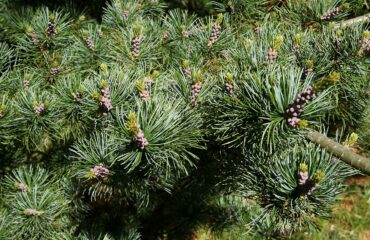Picea glauca var. albertiana, commonly known as Alberta Spruce, is a dwarf variety of the White Spruce, renowned for its dense, compact form and finely textured foliage. This slow-growing evergreen is a popular choice for ornamental gardens, especially in formal landscapes and small spaces. Propagating Alberta Spruce can be achieved through several methods: seed propagation, cutting propagation, and grafting. Each technique has its specific requirements, benefits, and challenges, which we will explore in detail.
Picea Glauca var. Albertiana (Alberta Spruce) Propagation Methods:
1. Seed Propagation
1.1. Seed Collection
Although less common for cultivars like Alberta Spruce due to variability in offspring, seed propagation is a natural and traditional method.
- Identifying Mature Cones: Alberta Spruce cones mature in late summer to early autumn. Look for small, brown cones that are starting to open.
- Harvesting Cones: Collect cones directly from the tree or the ground if they have recently fallen. Ensure cones are from a healthy, mature tree to obtain viable seeds.
1.2. Seed Preparation
Proper seed preparation is crucial for successful germination.
- Extracting Seeds: Dry the collected cones in a warm, dry place until they fully open. Extract the seeds by shaking or manually separating them from the cones.
- Cleaning and Stratification: Clean the seeds to remove any debris. Alberta Spruce seeds benefit from cold stratification to simulate winter conditions. Place seeds in a moist medium (such as peat or vermiculite) and store them in a refrigerator at 2-4°C (36-39°F) for 1-3 months.
1.3. Sowing and Germination
After stratification, the seeds are ready to be sown.
- Sowing Seeds: Plant the seeds in a well-draining, sterile potting mix, covering them lightly with soil or sand.
- Germination Environment: Place the seed trays in a bright area with indirect light. Maintain a temperature range of 15-20°C (59-68°F) and keep the soil consistently moist.
- Care for Seedlings: Germination typically occurs within 3-6 weeks. Once seedlings appear, continue to provide bright, indirect light and adequate moisture. Transplant seedlings into individual pots when they are strong enough to handle and have developed a robust root system.
2. Cutting Propagation
2.1. Selecting and Preparing Cuttings
Propagation through cuttings is ideal for maintaining the unique characteristics of Alberta Spruce cultivars.
- Choosing Cuttings: Select healthy, non-flowering shoots from the current year’s growth, preferably in late summer to early autumn.
- Preparing Cuttings: Cut sections 10-15 cm (4-6 inches) long from the shoots, just below a node. Remove the lower needles to expose the stem, which will be inserted into the rooting medium.
2.2. Rooting Hormones and Planting
Using rooting hormones can significantly improve the success rate of cuttings.
- Applying Rooting Hormone: Dip the base of each cutting into a rooting hormone powder or solution to stimulate root formation.
- Planting Cuttings: Insert the treated cuttings into a well-draining rooting medium, such as a mix of peat and perlite. Ensure the medium is moist and sterile to reduce the risk of fungal infections.
2.3. Rooting Environment and Care
Creating the right environment is essential for rooting cuttings.
- Maintaining Humidity: Use a humidity dome or plastic cover to maintain high humidity around the cuttings. This helps to reduce water loss through transpiration.
- Optimal Conditions: Place the cuttings in bright, indirect light and maintain a temperature range of 18-22°C (65-72°F). Keep the medium consistently moist but not waterlogged.
- Root Development: Roots should begin to form within 4-8 weeks. Gradually acclimate the rooted cuttings to lower humidity and more direct light before transplanting them into individual pots.
3. Grafting
3.1. Purpose of Grafting
Grafting is particularly useful for propagating specific Alberta Spruce cultivars to ensure uniform growth and desired characteristics.
- Advantages: Grafting allows for the combination of desirable traits from different plants. It is used to propagate named cultivars and to ensure consistent growth and form.
3.2. Grafting Techniques
Several grafting techniques are suitable for Alberta Spruce, each with specific benefits.
- Scion and Rootstock Selection: Choose a healthy scion from a desired Alberta Spruce cultivar and a compatible rootstock, usually from a vigorous White Spruce variety. The rootstock provides the root system, while the scion forms the above-ground portion.
- Cleft Grafting: Make a vertical split in the rootstock and insert the wedge-shaped scion into the cleft, ensuring good cambial contact for a strong union.
- Whip and Tongue Grafting: Both the scion and rootstock are cut with complementary slanting cuts, which are then fitted together. This method provides a strong union and good vascular connection.
3.3. Post-Grafting Care
Proper care after grafting is essential for the graft’s success and the plant’s health.
- Securing the Graft: Use grafting tape or wax to secure the graft union and prevent it from drying out. This also helps to keep the graft stable.
- Healing Environment: Place the grafted plants in a controlled environment with high humidity and stable temperatures to promote healing and growth.
- Monitoring and Maintenance: Regularly check the graft for signs of union success or failure and protect it from physical damage or disease. Once the graft is well-established, gradually acclimate the plant to outdoor conditions.
Conclusion
Propagating Picea glauca var. albertiana, or Alberta Spruce, involves methods like seed propagation, cutting propagation, and grafting, each catering to different needs and outcomes. Seed propagation, while less common for cultivars, provides genetic diversity. Cutting propagation is perfect for cloning specific characteristics, ensuring the maintenance of desirable traits. Grafting is ideal for combining the best attributes of different plants, especially for ornamental or superior cultivars. By mastering these techniques, gardeners and horticulturists can successfully propagate and enjoy the beauty of Alberta Spruce in their landscapes.
Share this article



